Kentucky Pest News Newsletter
HIGHLIGHTS IN THIS ISSUE
Number 1026__________June 21, 2004
CORN
FORAGE
SOYBEAN
VEGETABLES
SHADE TREES AND ORNAMENTALS
HOUSEHOLD
PESTICIDE NEWS AND VIEWS
DIAGNOSTIC LAB HIGHLIGHTS
IPM TRAP COUNTS

CORN
CORN ROOTWORM BEETLES HAVE EMERGED
By Ric Bessin
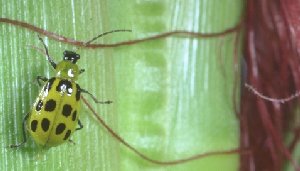 Western and Northern corn rootworm beetles are now
emerging from corn. While these are usually only an
economic problem in continuous corn in Kentucky,
growers need to monitor their fields this summer in order
to make control decisions for next year. Although corn
rootworm adults will strip the upper leaf surface during
the summer, this damage is minimal and does not usually
require any controls.
Western and Northern corn rootworm beetles are now
emerging from corn. While these are usually only an
economic problem in continuous corn in Kentucky,
growers need to monitor their fields this summer in order
to make control decisions for next year. Although corn
rootworm adults will strip the upper leaf surface during
the summer, this damage is minimal and does not usually
require any controls.
The adult Western corn rootworm is the most common
and is a 1/4 inch green leaf beetle with a few black
markings. During the next four to six weeks, the adults
will continue to emerge, mate and lay eggs. In fields where
the average number of adults is equal to or exceeds one
beetle per plant, growers will need to manage corn
rootworm in 2005. Options for rootworm control include;
crop rotation, soil insecticides (granular or liquid), seed
treatments, or use of Bt rootworm corn. First year corn in
Kentucky generally does not need to be treated for corn
rootworm.
For more information about corn pests, visit
"Insect Management Recommendations".


SOYBEAN
SOYBEAN APHID IN KENTUCKY / NEW WEB PAGES & NOTES FROM SURROUNDING STATES
By Doug Johnson
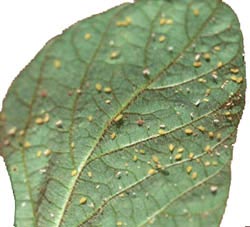 NEW WEBPAGES
NEW WEBPAGES
If you are interested in a wide variety of information
concerning the soybean aphid you are invited to view the
NEW KY-IPM Soybean Aphid web-pages. Go to the KY-
IPM home page at:
http://www.uky.edu/Agriculture/IPM/ipm.htm
Then click on the Soybean Aphid icon near the bottom of
the page.
Currently, these pages contain the expected outlook for
Kentucky in 2004, regional and national information, and
links to sites concerning this new pest. I anticipate adding
additional information sources as time permits.
These pages and Kentucky Pest News will remain one of
the first locations that new soybean aphid information will
be posted.
My appreciation is extended to Ms. Patty Lucas and Dr.
Pat Dillon for getting this new information site up and
running.
NOTES FROM SUROUNDING STATES
Illinois has not reported a population of soybean
aphids…yet! However, Michigan, Wisconsin and Iowa
have reported small populations. Illinois's situation is
probably the best predictor of the presence of soybean
aphid for the major concentration of Kentucky's
production.
Beware, in Iowa the first report of soybean aphid in 2004
was originally reported as thrips. Like aphids, thrips are
small insects. However, they inflict their damage with a
rasping mouth part. The surface tissue of the leaf is
removed leaving a lighter (at first) colored area, usually in
tiny streaks. In Kentucky thrips have also been associated
with "cupping" of soybean leaves. In 2003 my first
suspected soybean aphid field turn out to be thrips. These
insects are very common and will be found in all Kentucky
soybean fields. However, they rarely cause damage.
For more information about soybean pests, visit
"Insect Management Recommendations".


FORAGE
INVESTIGATIONS INTO FEED REFUSAL OF RED CLOVER
By Paul Vincelli
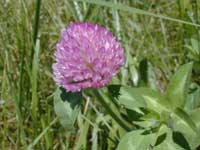 Although red clover and red clover/grass hays are very
suitable forages for many circumstances, red clover hay
has occasionally been refused by livestock. This is not a
new problem, but it is one for which the cause is still not
understood. When it occurs, it typically is a problem in
second or third cutting hay. There are many possibilities
as to the cause, including chemical changes that make the
hay unpalatable. One possible cause that has attracted my
attention is the presence of a fungus on the leaves and
stems of red clover that was refused by livestock.
Although red clover and red clover/grass hays are very
suitable forages for many circumstances, red clover hay
has occasionally been refused by livestock. This is not a
new problem, but it is one for which the cause is still not
understood. When it occurs, it typically is a problem in
second or third cutting hay. There are many possibilities
as to the cause, including chemical changes that make the
hay unpalatable. One possible cause that has attracted my
attention is the presence of a fungus on the leaves and
stems of red clover that was refused by livestock.
The fungus is called Rhizoctonia leguminicola. This fungus
causes the red clover disease called "Black Patch". Black
patch produces brown to gray-black leaf spots which often
have a "target-spot" appearance. Leaves and stems
eventually become blighted, turning dark brown. The
disease occurs only during warm, muggy weather in
second or later cuttings that go beyond full bloom.
Diseased forage contains the chemicals slaframine and
swainsonine, which are toxic to livestock. Black patch on
red clover is known to cause "Slobbers", where horses and
cattle that consume the hay slobber abundantly, producing
clear, viscous saliva for days.
Is the black patch fungus also responsible for feed refusal?
This has not been determined as of yet. However, this
question is "researchable", meaning that we can attempt to
answer the question by initiating a research program, and
this is exactly what is currently taking place at UK. The
Director of the new USDA Forage\Livestock, Dr. Jim
Strickland, has taken an interest in this question, along
with the other pressing priorities his group will address.
A cooperative USDA\UK research effort has begun to
explore possible causes of the feed-refusal problem,
including the possible connection between the black patch
fungus and feed refusal.
Producers who have red clover hay that has been clearly
and consistently refused by livestock may wish to contact
their county Extension Agent for Agriculture. Samples of
such hay could be useful in our preliminary investigations.

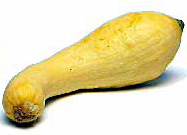
VEGETABLES
FRUIT ROTS OF STAKE TOMATOES AT A HIGHER LEVEL THAN NORMAL
By William Nesmith
 Tomato fruit rots have historically caused major losses for
tomato growers (both commercial and gardener) during
protracted wet weather, especially for unprotected fruits in
contact with the soil, or very near the soil, and during
post-harvest handling. In recent times, however, fruit rots
have been of minor importance for commercial tomato
growers that are using raised beds covered with film
mulch, stake the plants, and follow a regular spray
program to combat foliar and fruit diseases. This year,
growers in regions of Kentucky that have received excess
and frequent rains are reporting increased problems with
fruit rots, especially in areas of the field that experienced
standing surface water for several hours and their spray
intervals were opened up rather than closed up. Buckeye-
like rots (caused by Phytophthora species) are the main
problems, but Pythium species are also involved at a
significant level, too.
Tomato fruit rots have historically caused major losses for
tomato growers (both commercial and gardener) during
protracted wet weather, especially for unprotected fruits in
contact with the soil, or very near the soil, and during
post-harvest handling. In recent times, however, fruit rots
have been of minor importance for commercial tomato
growers that are using raised beds covered with film
mulch, stake the plants, and follow a regular spray
program to combat foliar and fruit diseases. This year,
growers in regions of Kentucky that have received excess
and frequent rains are reporting increased problems with
fruit rots, especially in areas of the field that experienced
standing surface water for several hours and their spray
intervals were opened up rather than closed up. Buckeye-
like rots (caused by Phytophthora species) are the main
problems, but Pythium species are also involved at a
significant level, too.
The losses are particularly serious to the lower clusters of
fruit, which are the first to ripen and normally bring the
highest price. During prolonged, warm wet weather like
we experienced last week, buckeye rot can affect a high
percentage of unprotected fruit that become contaminated
with the pathogen from muddy water and soil splashing
on the fruit. Most of the fungicide sprays that commercial
growers were using would have controlled buckeye rot,
had the material been in place on the fruit surface when
the spores arrive. Buckeye rot is not a major problem if
fungicides are applied properly for general control of foliar
and fruit diseases on a close schedule (5 to7-day schedule)
during warm, wet weather. Many growers with serious
problems allowed their spray intervals to become more
opened, rather than closing it; several with problems are
reporting spray intervals of 10-21 days.!
It is important to apply fungicides early, and to uniformly
cover all fruit with the fungicides, being sure that the
lower fruits and those in the center of each plant and the
undersides are also receiving the protective layer of
fungicide. Check and follow the manufacturer's
directions, but close the spray interval to the shortest
interval allowed in wet weather with fruit on the plants.
Fungicides are most needed for these diseases when the
soil is wet, so get them on if you find a period when the
spray will dry a few hours before the next rain event.
Operating from a sodded spray/drive strip, or walking-
them-on using back-pack mist blowers, becomes important
in the control of fruit diseases during protracted, periods
of warm, wet weather. Many growers told me that their
soils were too wet to support tractors for 10 days or longer
during one or more periods this season.
Growers and coops with these fruit rots will need to take
additional care during harvesting, handling, and
packaging to prevent spread, pathogen infiltration during
washing, and infection. Be very careful to keep all
fungicide applications legal, too. See ID-36, for more
details on the chemical options available. As a preventive
treatment, the use of mefenoxam (Ridomil Gold or Ultra
Flourish) in soil directed pre and post applications could
have greatly reduced losses from these diseases, but such
options are NOT available at these later stages of
production. Some consultants are advising growers to
spike foliar spray mixes with these materials labeled for
soil applications. But this approach can result in illegal and
detectable residues - destroying Kentucky's fresh market
tomato industry. I strongly urge Kentucky's vegetable
industry to apply only labeled products and in a manner
approved on the label.
SQUASH BUG ACTIVE
By Ric Bessin
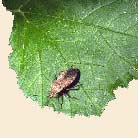 Squash bug adults are active in winter and summer
squashes. These inch-long sucking bugs damage cucurbit
plants by removal a large amounts of plant sap. With
transplants and small plants that have small, restricted
root systems, squash bugs can remove sap to the extent
that the plants wilt and may even die. Later in the summer
on larger plants, squash bugs remove the sap from leaves
and stems and can cause leaf yellowing and necrosis. More
importantly, squash bugs transmit the bacteria causing
Yellow Vine Decline in cucurbits.
Squash bug adults are active in winter and summer
squashes. These inch-long sucking bugs damage cucurbit
plants by removal a large amounts of plant sap. With
transplants and small plants that have small, restricted
root systems, squash bugs can remove sap to the extent
that the plants wilt and may even die. Later in the summer
on larger plants, squash bugs remove the sap from leaves
and stems and can cause leaf yellowing and necrosis. More
importantly, squash bugs transmit the bacteria causing
Yellow Vine Decline in cucurbits.
Squash bugs are commonly found on the undersides of
leaves where they lay their eggs. With plasticulture fields,
squash bugs are often at the base of the plants beneath the
plastic. The protection they get under the plastic may
make control with foliar sprays more difficult.
During the coming weeks, squash bug will lay eggs on the
undersides of leaves. Upon hatching, squash bug nymphs
resemble aphids. As they get older, they take on a grayish
appearance as they develop a waxy coat. Generally, they
younger nymphs are much easier to control than the larger
nymphs. In addition, treatments targeting the young
nymphs will facilitate superior coverage as the plant
canopy is smaller.
Because squash bugs persistently transmit the bacteria
causing Yellow Vine decline, control of the disease is
through early and effective control of the adult squash
bug. Many growers are using at-planting systemic
insecticides for control of cucumber beetles, these
treatments will also control squash bug for three to four
weeks after transplanting. As these treatments begin to
lose their effectiveness, growers need to monitor for
squash bugs and extend the control with foliar insecticides.


SHADE TREES AND ORNAMENTALS
WHITE PINES - AIR POLLUTION CAN CAUSE PREMATURE NEEDLE DROP
By John Hartman
 During recent weeks, white pines in central Kentucky and
in Lake Cumberland area counties, have been showing
symptoms of browning and premature loss of last year's
needles. The problem is most noticed in plantings having
many trees such as landscape screens and windbreaks or
Christmas tree plantations and nurseries, probably
because not all trees are involved and the problem is easier
to find where there are groups of trees. This problem has
left the affected trees quite bare, with the only green
foliage remaining being the needles just emerged from the
newest candles. On affected trees, clumps of dead needles
are easily combed out of the branches and are now brown;
earlier in spring, before the needles became desiccated,
these needles would have been a faded green color with
bands of yellow. The trees themselves are still very much
alive and the newly emerging needles are healthy, but
with foliage less dense than normal.
During recent weeks, white pines in central Kentucky and
in Lake Cumberland area counties, have been showing
symptoms of browning and premature loss of last year's
needles. The problem is most noticed in plantings having
many trees such as landscape screens and windbreaks or
Christmas tree plantations and nurseries, probably
because not all trees are involved and the problem is easier
to find where there are groups of trees. This problem has
left the affected trees quite bare, with the only green
foliage remaining being the needles just emerged from the
newest candles. On affected trees, clumps of dead needles
are easily combed out of the branches and are now brown;
earlier in spring, before the needles became desiccated,
these needles would have been a faded green color with
bands of yellow. The trees themselves are still very much
alive and the newly emerging needles are healthy, but
with foliage less dense than normal.
Based on specimens sent to the plant disease diagnostic
laboratory and on digital consulting cases submitted last
week, the problem is appearing over a widespread area in
central and southern Kentucky. Within the individual
plantings, perhaps 10-25% of the trees are affected and the
severity of the affected trees varies from almost complete
loss to loss of perhaps half of last year's needles. Many of
the trees growing in the same planting are not affected.
Normally on white pine, last year's needles turn yellow
and drop in the fall.
The likely cause of the premature defoliation is an air
pollution event sometime last summer. The symptoms we
are seeing are typical of oxidant air pollutants such as
ozone and peroxy acetyl nitrate (PAN), or possibly sulfur
dioxide. Injury to pines often occurs during warm
weather when pollutants accumulate in stagnant air. First
symptoms consist of yellow banding on the needles which
may be inconspicuous during the growing season. The
problem often intensifies during the winter and spring in
the form of browning and defoliation. Since these
pollutants are not usually confined to a small area, one
would expect symptoms to appear over a wide area of the
state. Although the exposure was general, not all trees
within a planting are affected. This variation within a
planting reflects genetic differences between trees grown
from seedlings and it is normal to see these different
responses to air pollution damage within a population of
white pines.
When did the air pollution event(s) occur? The following
information is based on consultations with Tom Priddy,
our U.K. Agricultural Meteorologist and information
obtained from the EPA AIRNow air quality web site. Last
year, being cooler and wetter than usual, there were few
hot, hazy days with elevated ozone levels. However,
elevated levels sufficient to cause plant symptoms may
have occurred on May 24, June 24-26, or August 26. For
sensitive plants, daily averages of 0.05 ppm or hourly
exposures of up to 0.1 ppm are sufficient to cause
symptoms. Thus, our best guess of when the damage we
are seeing now originated is last summer.
What is the prognosis for affected white pines? The
affected trees are not dead or even dying. They will
undoubtably be growing under some stress, at least until
the new needles are fully functioning, and even then they
will have fewer energy reserves than unaffected trees.
Growers will need to be sure that the affected trees receive
adequate water through the season and that infectious
diseases, insect pests, and weeds are managed. For now,
affected trees may not be as pleasing as they would have
been, but perhaps will be back to normal in another year.


HOUSEHOLD
WET SPRING CREATURES STILL MAKING PRESENCE FELT
By Lee Townsend
 Springtails, bark lice, and millipedes are frequent visitors
to the Insect ID lab via sample mailing tubes. Some of
these creatures thrive during periods when frequent rain
and high humidity provide favorable conditions and
promote mold growth that is an important food source.
Springtails, bark lice, and millipedes are frequent visitors
to the Insect ID lab via sample mailing tubes. Some of
these creatures thrive during periods when frequent rain
and high humidity provide favorable conditions and
promote mold growth that is an important food source.
Springtails are tiny wingless insects that can flip into the
air, giving them the appearance of tiny fleas. They would
go completely unnoticed except that hundreds can
accumulate on surfaces like a small, dusty gray carpet that
moves.
Many springtails live in rich soil or leaf litter associated
with fungi. Springtails become abundant among wet
leaves, soil, and plant material along a house foundations
or sidewalks where they can be a temporary annoyance.
They also can occur around floor drains, in damp
basements, and crawl spaces. Masses of these insects can
be swept up and discarded.
Most common springtails do not survive in dry conditions.
Any steps to improve ventilation and promote drying are
the best long term solutions. Removal of accumulations of
wet leaves or other organic matter will eliminate breeding
sites. Aerosol household insecticides can be used to treat
infestations but will provide only temporary relief if the
favorable conditions are not corrected.
Bark lice are light colored soft-bodied insects that can be
found clustered on tree trunks. They don't feed on leaves
or bark so they pose no problem but we usually don't see
them in great numbers.
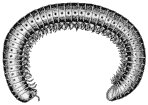 Finally, millipedes are nuisance invaders in some homes
now. Those what make it inside should be swept up and
discarded. They will not become established in the home
so there is no need for an insecticide application. The
source of these creatures may be heavily mulched areas
around the foundation or accumulations of leaves.
Removing these and promoting penetration of sunlight
and air circulation and help make the habitat unfavorable
to them. Also check door sweeps for a tight fit - this may
be the way they are gaining access to the home.
Finally, millipedes are nuisance invaders in some homes
now. Those what make it inside should be swept up and
discarded. They will not become established in the home
so there is no need for an insecticide application. The
source of these creatures may be heavily mulched areas
around the foundation or accumulations of leaves.
Removing these and promoting penetration of sunlight
and air circulation and help make the habitat unfavorable
to them. Also check door sweeps for a tight fit - this may
be the way they are gaining access to the home.


PESTICIDE NEWS AND VIEWS
QUINTEC, A NEW POWDERY MILDEW FUNGICIDE FOR GRAPES
By John Hartman
Quintec (quinoxyfen) fungicide is a new protectant
fungicide labeled for control of powdery mildew in grapes.
Quintec is normally applied on a 14-21 day schedule
starting early in the season before powdery mildew
infections begin. The fungicide is not to be used within 14
days of harvest and no more than 5 times per season. In
Kentucky, Quintec would likely be used in combination
with a black rot fungicide; it is compatible with other
commonly used fungicides and insecticides. Based on
information from the national Fungicide Resistance Action
Committee, this fungicide has a chemistry and mode of
action different from other fungicides such as strobilurins
and sterol biosynthesis inhibitors. Thus, it can be
alternated with these fungicides to help prevent fungicide
resistance development by the powdery mildew fungus.
Quintec is manufactured by Dow AgroSciences.


DIAGNOSTIC LAB HIGHLIGHTS
DIAGNOSTIC LAB - HIGHLIGHTS
By Julie Beale and Paul Bachi
Recent diagnostic samples have included Pythium root rot
on alfalfa and on soybean; head scab on wheat; angular
leaf spot, blue mold, target spot, black shank, Pythium root
rot, tomato spotted wilt virus, manganese toxicity and
temporary phosphorus deficiency on tobacco.
On fruit and vegetable samples, we have seen anthracnose
and black rot on grape; anthracnose on blueberry; brown
rot on cherry; early blight, bacterial speck, Septoria leaf
spot, Rhizoctonia stem rot, and tomato spotted wilt virus
on tomato; bacterial spot on pepper; and stinkbug injury
on sweet corn.
On ornamentals and turf, we have seen anthracnose on
begonia; stalk borer on lily; black root rot on petunia;
Phytophthora aerial blight, black root rot and Rhizoctonia
root rot on vinca; yellow poplar weevil injury on tuliptree
and magnolia; black spot on rose; leaf blister on oak;
anthracnose, brown patch and Drechslera leaf spot on
ryegrass; and melting out on bluegrass


IPM TRAP COUNTS:
By Patty Lucas, University of Kentucky Research Center
UKREC-Princeton, KY, June 11-18, 2004
| Black Cutworm
| 0
|
| True Armyworm
| 1
|
| Corn Earworm
| 3
|
| European Corn Borer
| 0
|
| European Corn Borer
| 1
|
|
To view previous trap counts for Fulton County, Kentucky
go to - http://ces.ca.uky.edu/fulton/anr/
and click on "Insect Trap Counts".
For information on trap counts in southern Illinois visit the
Hines Report at -
http://www.ipm.uiuc.edu/pubs/hines_report/index.html.
The Hines Report is posted weekly by Ron Hines, Senior
Research Specialist, at the University of Illinois Dixon
Springs Agricultural Center
NOTE: Trade names are used to simplify the information presented in
this newsletter. No endorsement by the Cooperative Extension Service
is intended, nor is criticism implied of similar products that are not
named.
Lee Townsend
Extension Entomologist
BACK
TO KY PEST NEWS HOME
 Western and Northern corn rootworm beetles are now
emerging from corn. While these are usually only an
economic problem in continuous corn in Kentucky,
growers need to monitor their fields this summer in order
to make control decisions for next year. Although corn
rootworm adults will strip the upper leaf surface during
the summer, this damage is minimal and does not usually
require any controls.
Western and Northern corn rootworm beetles are now
emerging from corn. While these are usually only an
economic problem in continuous corn in Kentucky,
growers need to monitor their fields this summer in order
to make control decisions for next year. Although corn
rootworm adults will strip the upper leaf surface during
the summer, this damage is minimal and does not usually
require any controls.



 NEW WEBPAGES
NEW WEBPAGES
 Although red clover and red clover/grass hays are very
suitable forages for many circumstances, red clover hay
has occasionally been refused by livestock. This is not a
new problem, but it is one for which the cause is still not
understood. When it occurs, it typically is a problem in
second or third cutting hay. There are many possibilities
as to the cause, including chemical changes that make the
hay unpalatable. One possible cause that has attracted my
attention is the presence of a fungus on the leaves and
stems of red clover that was refused by livestock.
Although red clover and red clover/grass hays are very
suitable forages for many circumstances, red clover hay
has occasionally been refused by livestock. This is not a
new problem, but it is one for which the cause is still not
understood. When it occurs, it typically is a problem in
second or third cutting hay. There are many possibilities
as to the cause, including chemical changes that make the
hay unpalatable. One possible cause that has attracted my
attention is the presence of a fungus on the leaves and
stems of red clover that was refused by livestock.

 Tomato fruit rots have historically caused major losses for
tomato growers (both commercial and gardener) during
protracted wet weather, especially for unprotected fruits in
contact with the soil, or very near the soil, and during
post-harvest handling. In recent times, however, fruit rots
have been of minor importance for commercial tomato
growers that are using raised beds covered with film
mulch, stake the plants, and follow a regular spray
program to combat foliar and fruit diseases. This year,
growers in regions of Kentucky that have received excess
and frequent rains are reporting increased problems with
fruit rots, especially in areas of the field that experienced
standing surface water for several hours and their spray
intervals were opened up rather than closed up. Buckeye-
like rots (caused by Phytophthora species) are the main
problems, but Pythium species are also involved at a
significant level, too.
Tomato fruit rots have historically caused major losses for
tomato growers (both commercial and gardener) during
protracted wet weather, especially for unprotected fruits in
contact with the soil, or very near the soil, and during
post-harvest handling. In recent times, however, fruit rots
have been of minor importance for commercial tomato
growers that are using raised beds covered with film
mulch, stake the plants, and follow a regular spray
program to combat foliar and fruit diseases. This year,
growers in regions of Kentucky that have received excess
and frequent rains are reporting increased problems with
fruit rots, especially in areas of the field that experienced
standing surface water for several hours and their spray
intervals were opened up rather than closed up. Buckeye-
like rots (caused by Phytophthora species) are the main
problems, but Pythium species are also involved at a
significant level, too.
 Squash bug adults are active in winter and summer
squashes. These inch-long sucking bugs damage cucurbit
plants by removal a large amounts of plant sap. With
transplants and small plants that have small, restricted
root systems, squash bugs can remove sap to the extent
that the plants wilt and may even die. Later in the summer
on larger plants, squash bugs remove the sap from leaves
and stems and can cause leaf yellowing and necrosis. More
importantly, squash bugs transmit the bacteria causing
Yellow Vine Decline in cucurbits.
Squash bug adults are active in winter and summer
squashes. These inch-long sucking bugs damage cucurbit
plants by removal a large amounts of plant sap. With
transplants and small plants that have small, restricted
root systems, squash bugs can remove sap to the extent
that the plants wilt and may even die. Later in the summer
on larger plants, squash bugs remove the sap from leaves
and stems and can cause leaf yellowing and necrosis. More
importantly, squash bugs transmit the bacteria causing
Yellow Vine Decline in cucurbits.

 During recent weeks, white pines in central Kentucky and
in Lake Cumberland area counties, have been showing
symptoms of browning and premature loss of last year's
needles. The problem is most noticed in plantings having
many trees such as landscape screens and windbreaks or
Christmas tree plantations and nurseries, probably
because not all trees are involved and the problem is easier
to find where there are groups of trees. This problem has
left the affected trees quite bare, with the only green
foliage remaining being the needles just emerged from the
newest candles. On affected trees, clumps of dead needles
are easily combed out of the branches and are now brown;
earlier in spring, before the needles became desiccated,
these needles would have been a faded green color with
bands of yellow. The trees themselves are still very much
alive and the newly emerging needles are healthy, but
with foliage less dense than normal.
During recent weeks, white pines in central Kentucky and
in Lake Cumberland area counties, have been showing
symptoms of browning and premature loss of last year's
needles. The problem is most noticed in plantings having
many trees such as landscape screens and windbreaks or
Christmas tree plantations and nurseries, probably
because not all trees are involved and the problem is easier
to find where there are groups of trees. This problem has
left the affected trees quite bare, with the only green
foliage remaining being the needles just emerged from the
newest candles. On affected trees, clumps of dead needles
are easily combed out of the branches and are now brown;
earlier in spring, before the needles became desiccated,
these needles would have been a faded green color with
bands of yellow. The trees themselves are still very much
alive and the newly emerging needles are healthy, but
with foliage less dense than normal.

 Springtails, bark lice, and millipedes are frequent visitors
to the Insect ID lab via sample mailing tubes. Some of
these creatures thrive during periods when frequent rain
and high humidity provide favorable conditions and
promote mold growth that is an important food source.
Springtails, bark lice, and millipedes are frequent visitors
to the Insect ID lab via sample mailing tubes. Some of
these creatures thrive during periods when frequent rain
and high humidity provide favorable conditions and
promote mold growth that is an important food source.
 Finally, millipedes are nuisance invaders in some homes
now. Those what make it inside should be swept up and
discarded. They will not become established in the home
so there is no need for an insecticide application. The
source of these creatures may be heavily mulched areas
around the foundation or accumulations of leaves.
Removing these and promoting penetration of sunlight
and air circulation and help make the habitat unfavorable
to them. Also check door sweeps for a tight fit - this may
be the way they are gaining access to the home.
Finally, millipedes are nuisance invaders in some homes
now. Those what make it inside should be swept up and
discarded. They will not become established in the home
so there is no need for an insecticide application. The
source of these creatures may be heavily mulched areas
around the foundation or accumulations of leaves.
Removing these and promoting penetration of sunlight
and air circulation and help make the habitat unfavorable
to them. Also check door sweeps for a tight fit - this may
be the way they are gaining access to the home.


